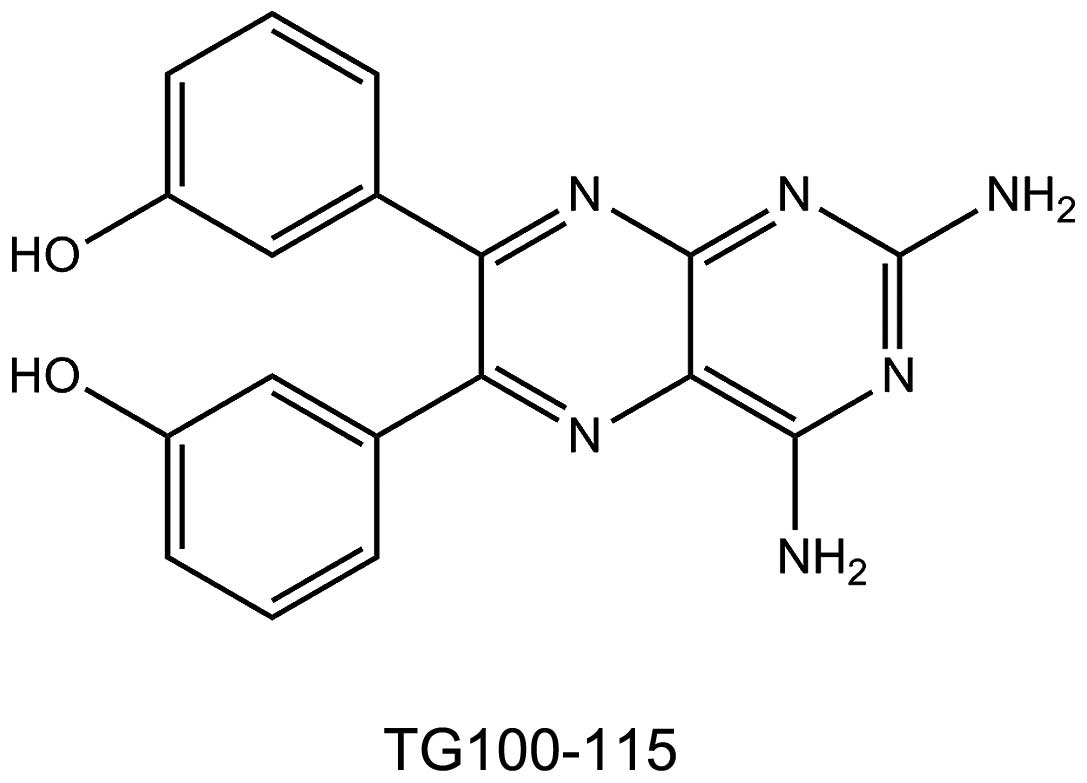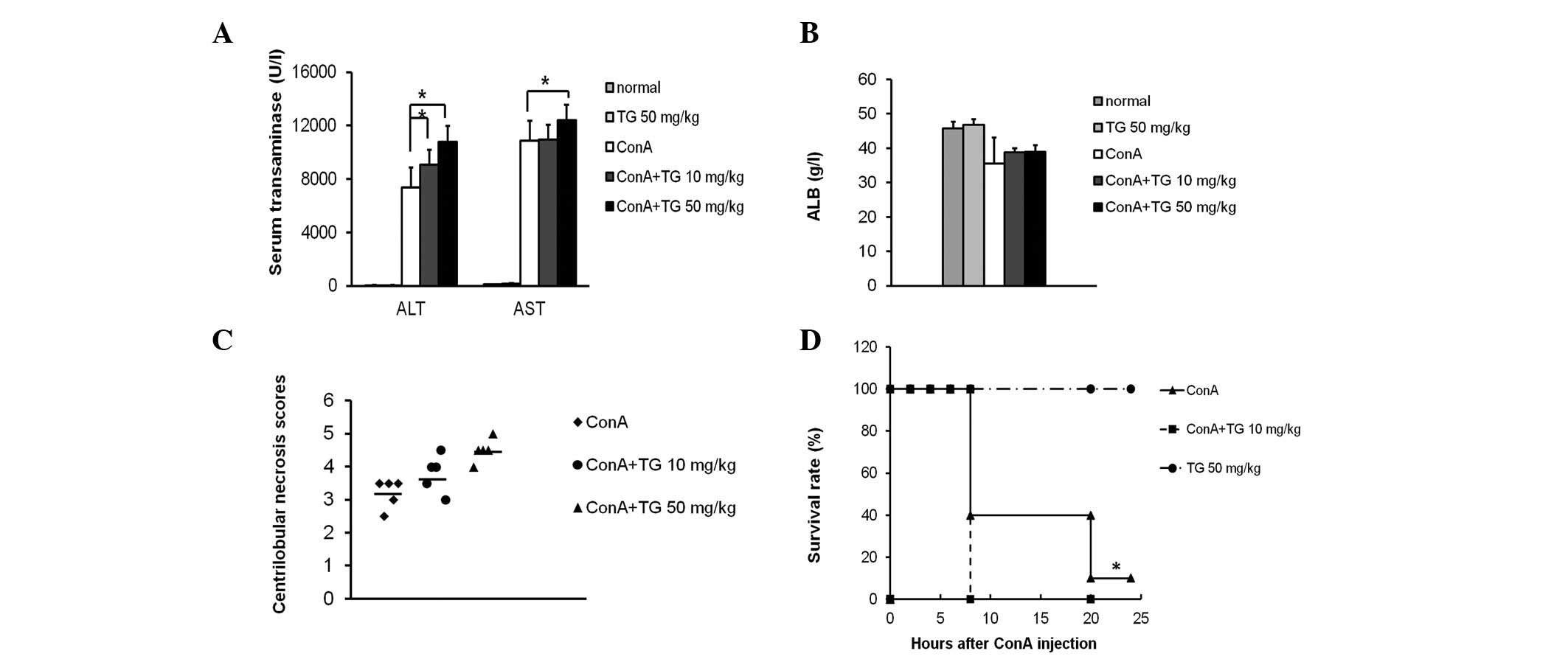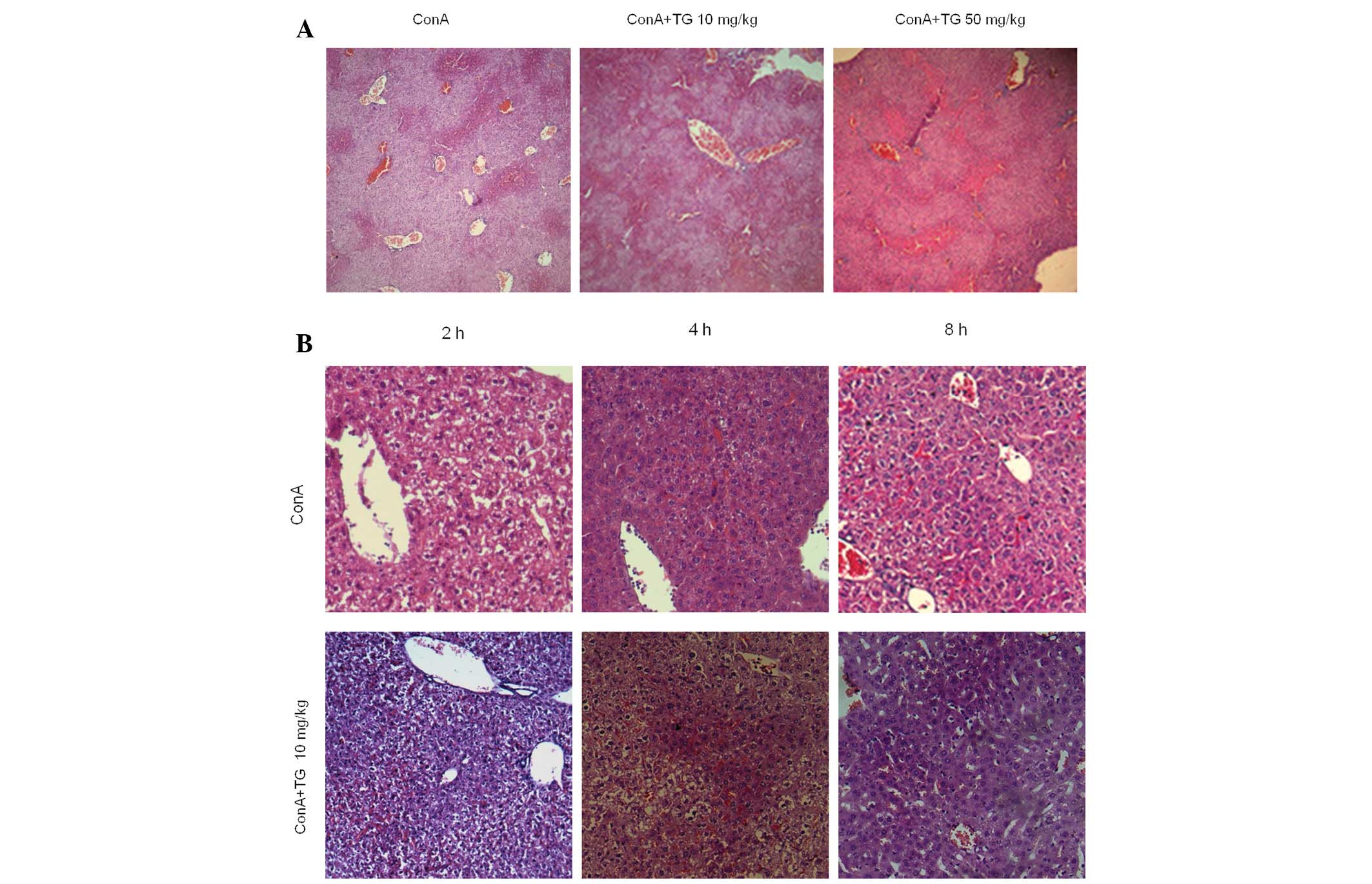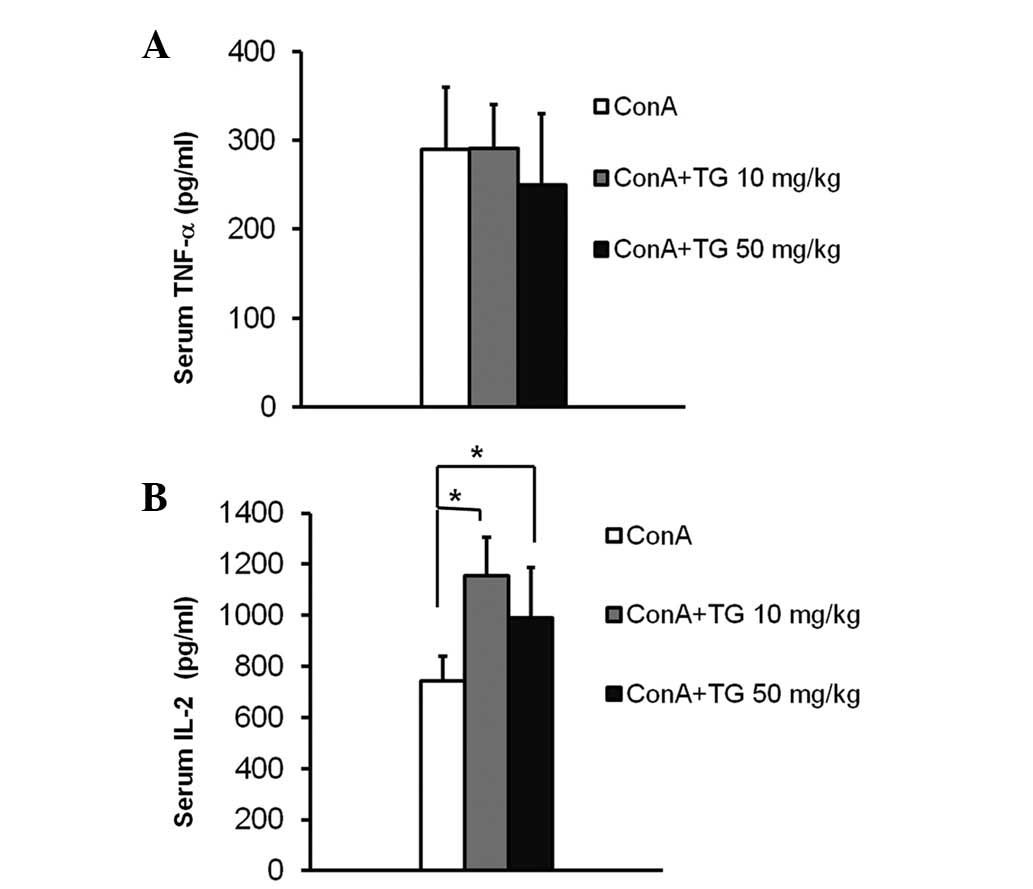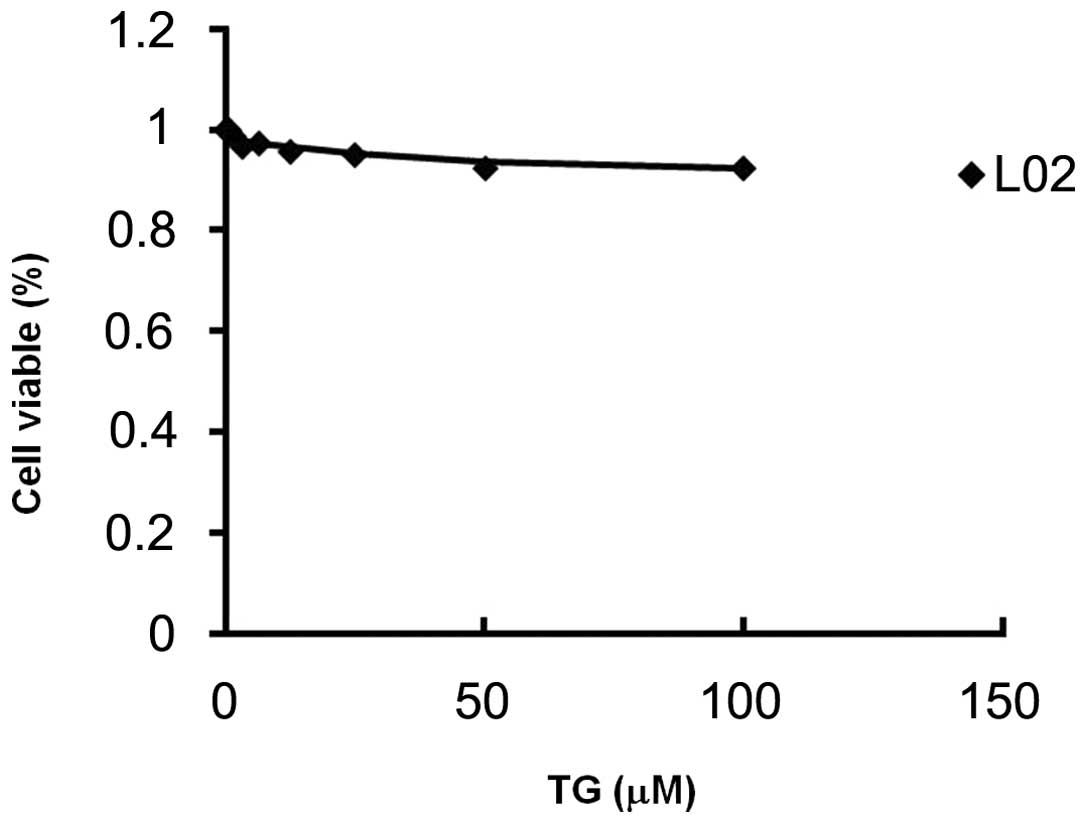Phosphoinositide 3‑kinase δ/γ inhibition does not prevent concanavalin A‑induced hepatitis
- Authors:
- Published online on: August 22, 2013 https://doi.org/10.3892/mmr.2013.1649
- Pages: 1305-1310
Abstract
Introduction
Phosphoinositide 3-kinase-γ (PI3Kγ) and PI3Kδ, which belong to the class I PI3K family, are essential for inflammatory cell signaling (1). PI3Kδ and PI3Kγ are primarily limited to hematopoietic and endothelial cells (2,3). Activated by downstream receptor tyrosine kinases and G-protein coupled receptors, respectively (4), PI3Kδ and PI3Kγ lead to the formation of phosphatidylinositol-(3,4,5)-triphosphate (PIP3) and the phosphorylation of Akt. The interaction of phospho-Akt with PIP3 at the cell membrane stimulates the phosphorylation of downstream targets that regulate several inflammatory and immune functions, including the recruitment of activated T cells, macrophages and neutrophils (2). Studies using genetic deletion and benchmark compounds have demonstrated that the most effective anti-inflammatory PI3K inhibitor inhibits PI3Kδ and PI3Kγ by markedly affecting anti-inflammatory markers in T cell and monocyte-driven environments, with concurrent antiproliferative effects (5). Therefore, studies concerning PI3Kγ and PI3Kδ have generated interest in the development of PI3Kδ/γ inhibitors as therapeutic agents for the treatment of autoimmune and inflammatory diseases.
Regardless of numerous studies, the mechanisms of PI3Kδ/γ in inflammatory diseases, such as hepatitis, remain to be elucidated. Pharmacological inhibition of PI3Kγ has been demonstrated to exert a therapeutic effect on hepatic injury in mice (6); however, the effect of PI3Kδ/γ in this process is unclear. ConA-induced acute hepatitis, which is characterized by hepatic necrosis and inflammatory cell infiltration, is commonly used as an experimental animal model for human liver disease (7). In the present study, we hypothesized that the pharmacological inactivation of PI3Kδ/γ may interfere with the pathology of ConA-induced hepatitis and thereby impact the functional recovery of the injured liver.
TG100-115, a dual PI3Kγ and δ-selective inhibitor was used to investigate its potential effect on ConA-induced acute hepatitis in mice. Notably, this study determined that the pharmacological inhibition of PI3Kδ/γ by TG100-115 did not prevent liver damage following ConA challenge. Furthermore, TG100-115 aggravated liver damage by elevating transaminase activity and IL-2 levels in sera, and by promoting hepatic necrosis and hepatocyte apoptosis. This suggested that the inhibition of PI3Kγ and PI3Kδ may be involved in the pathogenesis of acute hepatitis induced by ConA. To the best of our knowledge, these results may be the first to warn against the development of PI3Kδ/γ inhibitors as therapeutic agents for the prevention and treatment of hepatitis in humans.
Materials and methods
Reagents
TG100-115 was synthesized (purity, >99.5%) in our laboratory (Sichuan University) according to previous studies (8,9). The purity and structural identification of TG100-115 were confirmed by high performance liquid chromatography, mass spectrometry and nuclear magnetic resonance (Bruker Avance 400 NMR system; Bruker, Billerica, MA, USA) (Fig. 1). ConA (type IV) was purchased from Sigma-Aldrich (St. Louis, MO, USA).
Animals
Female BALB/C mice (age, 6–8 weeks; weight, 20–24 g) were obtained from the Western China Experimental Animal Center (Sichuan, China) and maintained in a temperature and humidity controlled environment in a 12-h light-dark cycle, and were allowed free access to water and food. All mice received human care and all experimental procedures in the study were handled according to the guidelines for the humane care of laboratory animals established by Sichuan University (Chengdu, Sichuan, China), and the study protocol was approved by the local ethics committee (Chengdu, Sichuan, China).
Experimental protocol
TG100-115 was dissolved in vehicle (10% hydroxypropyl-β-cycloamylose) and a 1.5 mg/ml solution of ConA was produced in sterile saline. For the investigation of the dose-response relationship for TG100-115, mice were treated with TG100-115 [10 or 50 mg/kg; intraperitoneally (ip)], followed by ConA (15 mg/kg) or solvent [intravenously (iv)] after 0.5 h (10). Mice treated with ConA (15 mg/kg, iv) were sacrificed 2, 4, 8 or 20 h following treatment. Sera were collected 20 h following ConA challenge to determine the levels of serum alanine aminotransaminase (ALT), asparate aminotransaminase (AST) and albumin (ALB), and livers were harvested for hematoxylin and eosin (H&E) staining. The levels of tumor necrosis factor (TNF)-α and interleukin (IL)-2 in the sera were analyzed at 2 and 4 h with commercial enzyme-linked immunosorbent assay (ELISA) kits (Mouse TNF-α ELISA and Rouse IL-2 ELISA kits, respectively; Dakewe Biotech, Co., Ltd., Nanshan, Shenzen, China) according to the manufacturer’s instructions. The apoptosis of hepatocytes at 2 and 4 h was determined by Hoechst staining. In a survival test, mice were treated with a lethal dose of ConA (30 mg/kg, iv), followed by TG100-115 (10 mg/kg, ip) or vehicle (11) after 0.5 h, and then monitored for survival every 2 h.
Evaluation of liver enzymes
Liver injury was determined by the measurement of serum ALT, AST and ALB levels by the Chemical Lab in the National Chengdu Center for Safety Evaluation of Drugs (Chengdu, Sichuan, China).
H&E and Hoechst staining
Formalin-fixed liver samples were embedded in paraffin, and 4-μm sections were stained with H&E or Hoechst staining (Beyotime Biotech, Jiangsu, China) according to the manufacturer’s instructions (6). The stained liver sections were examined using light microscopy followed by fluorescence microscopy. Histological scores of centrilobular necrosis for individual mice (n=10) 20 h following ConA injection are presented. Histological slides were evaluated by a board of certified veterinary pathologists without the knowledge of the treatment groups. Histopathological changes were graded and recorded on a severity scale of 0 to 5 (0, no lesion; 1, minimal; 2, mild; 3, moderate; 4, marked; 5, severe) (11).
Detection of cytokines by ELISA
Mice treated with TG100-115 (10 mg/kg, ip) 0.5 h following ConA challenge were sacrificed 2 or 4 h following ConA injection. Serum levels of TNF-α and IL-2 were analyzed by ELISA using commercially available kits (Dakewe Biotech, Co., Ltd.) according to the manufacturer’s instructions. TNF-α and IL-2 levels were measured 2 and 4 h following ConA challenge, respectively (12,13).
Assessment of the cytotoxicity of TG100-115 in vitro
The direct effect of TG100-115 on hepatocytes was determined by a colorimetric method using methyl thiazolyl tetrazolium (MTT) dye. Human liver cell line, L-02 (HL-7702), was used to assess the cytotoxicity of TG100-115. TG100-115 was added to cells in a doubling dilution manner at a series of doses (100, 50, 25, 12.5, 6.25, 3.13, 1.56 and 0.75 μM) for a 24 h coculture. The percentage of viable cells was determined by the conversion of MTT to its formazan derivative in each well. This was conducted by comparing the optical density at 570 nm (OD570) of the wells with that of the drug-free control based on the following equation: (A570 of wells that contained the drug/A570 of the drug-free wells) × 100%. IC50 (the concentration of 50% maximal inhibition of cell growth) was determined by interpolation of the dose-response curves.
Statistical analysis
Student’s t-test was used to determine the significance of differences between vehicle controls and experimental groups. P<0.05 was considered to indicate a statistically significant difference.
Results
PI3Kδ/γ inhibition aggravates acute liver injury of mice induced by ConA
TG100-115 (10 and 50 mg/kg) significantly increased the serum ALT and AST levels in ConA-induced mice (Fig. 2A). ALB (synthesized in the liver), ALT and AST are indicators of liver function. The average level of ALB in normal mice is 47 g/l, while that in ConA-treated mice decreased to 35 g/l, indicating that ConA induced hypohepatia, in accordance with the change in the transaminase levels. However, there was no significant difference in the ALB levels between the control and TG100-115 groups (Fig. 2B), indicating that TG100-115 does not effect the ALB levels in acute hepatitis. The livers from ConA-treated mice with hepatitis exhibited inflammatory cell infiltration, dilatation and congestion of the blood vessels, as well as widespread hepatocellular necrosis in the liver lobules. In addition, the inflammatory cell infiltration and the necrotic regions were also markedly increased by TG100-115 (50 mg/kg) treatment (Fig. 3A). Histological scores of centrilobular necrosis for individual mice demonstrated that ConA induced a lower score (3.29±0.49) compared with that for TG100-115 treatment (10 or 50 mg/kg), which significantly increased the scores to 4.09±0.51 and 4.50±0.71, respectively (Fig. 2C). As severe liver damage may be fatal in mice, increased liver damage is correlated with an increased mortality rate. Following a lethal dose of 30 mg/kg ConA, 90% of the ConA-treated mice succumbed within 24 h. By contrast, mice pretreated with TG100-115 (15 mg/kg) demonstrated an increased mortality rate with 100% of mice no longer surviving within 8 h. These results indicated that TG100-115 exerted a detrimental effect on ConA-induced hepatitis in mice (Fig. 2D).
Histological analysis of the effect of TG100-115 on liver inflammatory infiltration and hepatocyte apoptosis
Liver tissues of TG100-115-treated and untreated mice were harvested for H&E staining 2 and 4 h following ConA challenge (13). An increased number of inflammatory cells in the central veins and the sinusoids of the livers from mice with ConA-induced hepatitis were observed. Furthermore, TG100-115 treatment increased the apoptosis of hepatocytes in the portal area compared with that of the control (Fig. 3B). Hoechst staining was used to further investigate the apoptosis of hepatocytes. The liver tissue sections from ConA and TG100-115-treated mice demonstrated greater quantities of condensed chromatin and nuclear fragmentation (which are characteristics of cells undergoing apoptosis) than those with ConA treatment alone (Fig. 4). These results suggested that interference of PI3Kδ/γ signaling by TG100-115 modified the inflammatory cell recruitment that is responsible for the development of ConA-induced hepatic injury. Thus, TG100-115 may aggravate hepatocyte apoptosis induced by ConA in vivo.
TG100-115 modulates ConA-induced cytokine production
TNF-α and IL-2, key inflammatory cytokines mainly secreted by neutrophils and T cells, are essential in the development of ConA-induced acute hepatitis (14). To determine the effect of TG100-115 in modulating the production of these key inflammatory cytokines, we analyzed the TNF-α and IL-2 protein levels in serum of mice with ConA-induced hepatitis and observed their changes following TG100-115 treatment. TNF-α levels in the serum were elevated to 300 pg/ml 2 h following ConA injection, the peak time point according to previous studies (12), and marginally changed following TG100-115 treatment (Fig. 5A). In a previous study, the peak serum level of IL-2 was detected at 4 h following ConA injection (13). TG100-115 treatment resulted in an increase in IL-2 serum levels compared with those of ConA-treated mice 4 h following ConA injection (Fig. 5B). This increase suggested that the inhibition of PI3Kδ/γ by TG100-115 may modulate ConA-induced T cell activation in vivo.
Toxicity of TG100-115
Following exposure to various concentrations of TG100-115 for 24 h, the percentage of viable L-02 cells was assessed by MTT assay. Results revealed that TG100-115 (at a concentration of 100 μM) had no effect on the percentage of viable L-02 cells (Fig. 6). The IC50 value of TG100-115 on L-02 cells was >100 μM, indicating that TG100-115 did not significantly reduce the viability of hepatic cells in vitro (Table I).
Discussion
Studies using genetic deletion and benchmark compounds have demonstrated that the most effective anti-inflammatory PI3K inhibitor inhibits PI3Kδ and PI3Kγ (5) by affecting anti-inflammatory markers in T cell- and monocyte-driven environments, with concurrent antiproliferative effects. This raises the possibility that pharmacological inactivation of PI3Kδ and PI3Kγ may be used for the treatment of hepatitis. However, regardless of its demonstrated preventive effect, also confirmed by us (data not shown), TG100-115 failed to reduce, and even aggravated, the progression of hepatic injury. This aggravation occurred in a time- and dose-dependent manner, as indicated by the elevated transaminase activity in the serum and the increased hepatic necrosis. In the survival test, TG100-115 resulted in increased mortality compared with that of mice challenged with ConA alone.
PI3Kδ/γ is important in the development of T lymphocytes and other related cellular functions (15). The dual PI3Kδ/γ knockout mouse has been demonstrated to be viable but to exhibit serious defects in thymocyte survival and T cell development (16,17). Dual targeting of PI3Kδ/γ has resulted in enhanced inhibition of overall T cell activation and LPS-induced TNF-α production (1). TG100-115, a dual PI3Kδ/γ inhibitor, has been identified to reduce the severity of asthma in a murine model by reducing pulmonary eosinophilia and the concomitant interleukin-13 levels (18). T lymphocyte activation is the predominant pathology in human and ConA-induced hepatitis (19). In the present study, it was demonstrated that TG100-115 treatment did not block ConA-induced T cell accumulation in the liver. Contrary to this, T cell hepatic infiltration appeared to increase following TG100-115 treatment in ConA-hepatitis mice. This was in accordance with the aggregated IL-2 secretion in the serum of TG100-115 treated mice in vivo. IL-2, IFN-γ and TNF-α are cytokines secreted by Th1 T cells, which enhance the Th1 immune response. Therefore, it was hypothesized that aggravated progression of hepatic injury by TG100-115 in ConA-induced hepatitis may be due to the stimulation of T cells or a T cell subtype. Mice immunized with ConA-activated autologous T cells demonstrated dampened regulatory T cell (Treg) function, which may have contributed to an enhanced Th1 response in vivo(20). It has been determined that Tregs are important in immune system homeostasis and that the Th1–Th2 balance was partially impaired in p110γKO/δD910A mice compared with the wild type (15). In the present study, the pharmaceutical inhibition of PI3Kδ/γ by TG100-115 (as a result of a loss of Th1–Th2 balance) and the increased levels of IL-2 in the serum may have resulted in a dominant Th1 immune response with TG100-115 treatment following ConA injection. Therefore, it may be beneficial to identify the precise mechanism of PI3Kδ/γ in T lymphocyte differentiation, and the balance of Th1 and Th2 during ConA-induced hepatitis development.
Numerous clinical anti-inflammatory agents function through different targets, yet all inhibit immune cell function while leaving nonimmune cells relatively unaffected. An MTT analysis on the liver cell line L-02 was performed to determine whether the PI3Kδ/γ inhibitors exhibited this property. The IC50 value of TG100-115 on L-02 cells was >100 μM, which indicated that TG100-115 did not demonstrate growth inhibition in L-02 cells in vitro. However, mice treated with TG100-115 resulted in earlier and markedly greater hepatocyte apoptosis than that of mice receiving ConA alone. This indicated that TG100-115 aggravated ConA-induced hepatitis via an immune-mediated mechanism, irrespective of TG100-115 alone.
In this study, it was demonstrated that the pharmacological inhibition of PI3Kδ/γ did not prevent ConA-induced acute hepatic injury in vivo. This indicates that PI3Kγ and PI3Kδ may be involved in the process of acute hepatitis induced by ConA. These results may suggest against the development of inhibitors of PI3Kδ/γ as therapeutic agents for the treatment of human hepatitis.
Acknowledgements
This study was supported by the National Natural Science Foundation of China (grant no. 8100093).
References
|
Williams O, Houseman BT, Kunkel EJ, et al: Discovery of dual inhibitors of the immune cell PI3Ks p110delta and p110gamma: a prototype for new anti-inflammatory drugs. Chem Biol. 17:123–134. 2010. View Article : Google Scholar : PubMed/NCBI | |
|
Deane JA and Fruman DA: Phosphoinositide 3-kinase: diverse roles in immune cell activation. Annu Rev Immunol. 22:563–598. 2004. View Article : Google Scholar : PubMed/NCBI | |
|
Puri KD, Doggett TA, Douangpanya J, et al: Mechanisms and implications of phosphoinositide 3-kinase delta in promoting neutrophil trafficking into inflamed tissue. Blood. 103:3448–3456. 2004. View Article : Google Scholar : PubMed/NCBI | |
|
Katso R, Okkenhaug K, Ahmadi K, White S, Timms J and Waterfield MD: Cellular function of phosphoinositide 3-kinases: implications for development, homeostasis, and cancer. Annu Rev Cell Dev Biol. 17:615–675. 2001. View Article : Google Scholar : PubMed/NCBI | |
|
Marone R, Cmiljanovic V, Giese B and Wymann MP: Targeting phosphoinositide 3-kinase: moving towards therapy. Biochim Biophys Acta. 1784:159–185. 2008. View Article : Google Scholar : PubMed/NCBI | |
|
Wang ZL, Wu XH, Song LF, et al: Phosphoinositide 3-kinase gamma inhibitor ameliorates concanavalin A-induced hepatic injury in mice. Biochem Biophys Res Commun. 386:569–574. 2009. View Article : Google Scholar : PubMed/NCBI | |
|
Tiegs G, Hentschel J and Wendel A: A T cell-dependent experimental liver injury in mice inducible by concanavalin A. J Clin Invest. 90:196–203. 1992. View Article : Google Scholar : PubMed/NCBI | |
|
Palanki MS, Dneprovskaia E, Doukas J, et al: Discovery of 3,3′-(2,4-diaminopteridine-6,7-diyl) diphenol as an isozyme-selective inhibitor of PI3K for the treatment of ischemia reperfusion injury associated with myocardial infarction. J Med Chem. 50:4279–4294. 2007. | |
|
Ichihara M, Suzuki H, Mohr B and Ohta K: Different disk structures in the hexagonal columnar mesophases of 2,3-dicyano-6,7,10,11-tetraalkoxy-1,4-diazatriphenylenes and 2,3-dicyano-6,7,10,11-tetraalkoxytriphenylenes. Liq Cryst. 34:401–410. 2007. View Article : Google Scholar | |
|
Wolf AM, Wolf D, Rumpold H, et al: The kinase inhibitor imatinib mesylate inhibits TNF-α production in vitro and prevents TNF-dependent acute hepatic inflammation. Proc Natl Sci USA. 102:13622–13627. 2005. | |
|
Bozza M, Bliss JL, Maylor R, et al: Interleukin-11 reduces T-cell-dependent experimental liver injury in mice. Hepatology. 30:1441–1447. 2003. View Article : Google Scholar : PubMed/NCBI | |
|
Fougerat A, Gayral S, Gourdy P, et al: Genetic and pharmacological targeting of phosphoinositide 3-kinase-gamma reduces atherosclerosis and favors plaque stability by modulating inflammatory processes. Circulation. 117:1310–1317. 2008. View Article : Google Scholar | |
|
Casini A, Ricci OE, Paoletti F and Surrenti C: Immune mechanisms for hepatic fibrogenesis. T-lymphocyte-mediated stimulation of fibroblast collagen production in chronic active hepatitis. Liver. 5:134–141. 1985. View Article : Google Scholar | |
|
Camps M, Rückle T, Ji H, et al: Blockade of PI3Kgamma suppresses joint inflammation and damage in mouse models of rheumatoid arthritis. Nat Med. 11:936–943. 2005.PubMed/NCBI | |
|
Ji H, Rintelen F, Waltzinger C, et al: Inactivation of PI3Kgamma and PI3Kdelta distorts T-cell development and causes multiple organ inflammation. Blood. 110:2940–2947. 2007. View Article : Google Scholar : PubMed/NCBI | |
|
Swat W, Montgrain V, Doggett TA, et al: Essential role of PI3Kdelta and PI3Kgamma in thymocyte survival. Blood. 107:2415–2422. 2006. View Article : Google Scholar : PubMed/NCBI | |
|
Webb LM, Vigorito E, Wymann MP, Hirsch E and Turner M: Cutting edge: T cell development requires the combined activities of the p110gamma and p110delta catalytic isoforms of phosphatidylinositol 3-kinase. J Immunol. 175:2783–2787. 2005. View Article : Google Scholar : PubMed/NCBI | |
|
Doukas J, Eide L, Stebbins K, et al: Aerosolized phosphoinositide 3-kinase gamma/delta inhibitor TG100-115 [3-[2, 4-diamino-6-(3-hydroxyphenyl) pteridin-7-yl] phenol] as a therapeutic candidate for asthma and chronic obstructive pulmonary disease. J Pharmacol Exp Ther. 328:758–765. 2009.PubMed/NCBI | |
|
Dienes HP, Hütteroth T, Hess G and Meuer SC: Immunoelectron microscopic observations on the inflammatory infiltrates and HLA antigens in hepatitis B and non-A, non-B. Hepatology. 7:1317–1325. 1987. View Article : Google Scholar : PubMed/NCBI | |
|
Cao Q, Wang L, Du F, et al: Downregulation of CD4+ CD25+ regulatory T cells may underlie enhanced Th1 immunity caused by immunization with activated autologous T cells. Cell Res. 17:627–637. 2007. |



